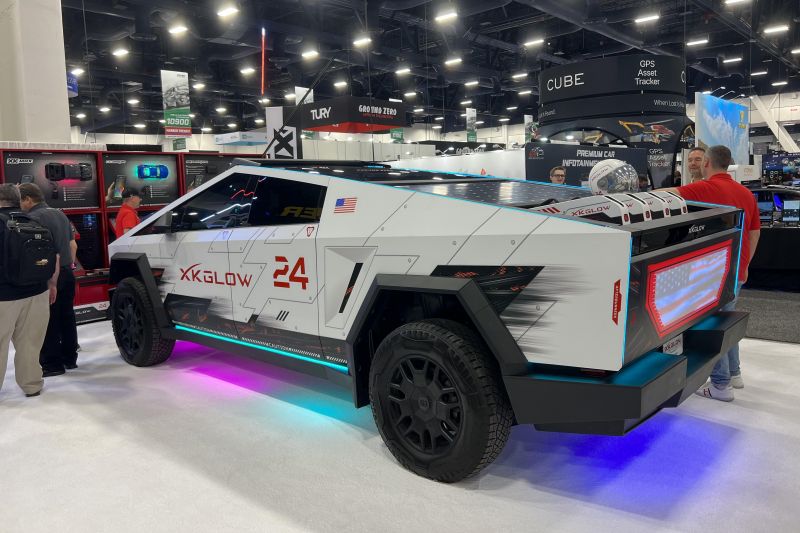The Tesla Cybertruck is already a dramatic-looking vehicle, and this year’s SEMA aftermarket show showed this electric ute is ripe for customisation.
SEMA, the Specialty Equipment Market Association exhibition, is the world’s premier event for automotive customisation and aftermarket innovation. Held over November 5-8, the 2024 edition once again showcased everything from classic muscle cars to the latest in off-road engineering.
But this year, something different grabbed attention in serious numbers: the Tesla Cybertruck.
100s of new car deals are available through CarExpert right now. Get the experts on your side and score a great deal. Browse now.
This futuristic, all-electric truck made its SEMA debut in force, and it certainly got people talking.
Last year, the Cybertruck was notably absent from SEMA, with only a few early prototypes circulating in the automotive world. Supply chain delays, production challenges, and Tesla’s struggle to scale the Cybertruck’s unconventional stainless-steel body contributed to the delay.
Now, with deliveries finally rolling out, Cybertrucks flooded the floor, with a number of examples kitted out for off-road and overlanding in ways that were almost as divisive as the truck itself.
Off-road appeal and limitations
The Cybertruck’s appearance at SEMA drew a mixed crowd.
On one hand, it presents with a range of moderate off-road credentials: a claimed 35-degree approach angle, 28-degree departure angle, and up to 406mm of ground clearance thanks to adaptive air suspension.
The truck’s design, which looks like something out of a sci-fi movie, is undeniably bold and eye-catching. For urban adventurers and tech enthusiasts, this futuristic aesthetic is a huge selling point. The stainless-steel exoskeleton, while polarizing, offers serious durability and an unorthodox approach to vehicle design.
But off-road purists have plenty of reservations. The Cybertruck’s sheer size and weight—potentially tipping the scales at over 3000kg—raise questions about how nimble it truly is off-road.
EVs have a tendency to struggle in extreme conditions where traditional internal combustion engines shine, such as long stretches of soft sand or deep mud. Battery performance, especially in remote areas where charging infrastructure is nonexistent, remains a major limitation.
While the Cybertruck’s estimated range of up to 800km is impressive, how reliable will it be when you’re far from civilisation and towing a heavy load?
Range anxiety is a very real concern for adventurers who love to explore Australia’s most isolated landscapes.
Enthusiasts love it or hate it
The Cybertruck has an uncanny ability to divide opinions. Some enthusiasts see it as the future of off-roading: a zero-emissions vehicle that can apparently take on wild trails while turning heads at every campfire.
Others view it as an impractical gimmick, a tech experiment better suited for the streets of Silicon Valley than the rugged Australian outback. The truck’s performance specs are undeniably impressive. With a tri-motor setup promising a 0-100km/h time of under three seconds, the Cybertruck has speed and torque in spades.
And yet, off-road, performance isn’t just about power. Manoeuvrability, reliability, and the ability to handle harsh conditions play equally important roles.
Inside, the cabin’s minimalist design and enormous touchscreen dashboard have divided opinions even further. The lack of traditional gauges, reliance on software updates, and Tesla’s typically polarising user interface are either seen as game-changing innovations or as features that detract from the rugged simplicity that many off-road enthusiasts value.
And while Tesla’s Autopilot and Full Self-Driving systems are groundbreaking in urban settings, how much of that tech will prove useful – or even functional – when you’re navigating an unmarked desert track?
The towing question
One of the biggest questions surrounding the Cybertruck at SEMA was how well it can perform while towing.
With a towing capacity of up to 6350kg, it sounds like a game-changer on paper. However, towing comes with significant impacts on range, a challenge that internal-combustion engines also face but to a lesser extent.
In an EV, hauling a heavy load over long distances can deplete battery reserves alarmingly quickly. Imagine towing a fully loaded trailer out to a remote campsite, only to find your range severely cut and no way to recharge.
Until EV charging infrastructure becomes more widespread in rural and remote areas, this remains a daunting issue for EV adventurers.
Future potential and SEMA surprises
Despite the scepticism, SEMA 2024 was full of surprises. Seeing multiple Cybertrucks outfitted for serious overlanding and off-roading – complete with rooftop tents, modified bumpers, and taller off-road tyres – was a sight many had not anticipated.
The aftermarket world has quickly jumped on board, creating custom accessories to make the Cybertruck more off-road capable. It’s a testament to the vehicle’s appeal that so many companies are willing to invest in making it better suited for rugged adventures.
So, what is the future of the Tesla Cybertruck as an off-road vehicle? It certainly has potential, and for those willing to invest in the right gear and tackle its limitations, it could become a serious player in the world of adventure travel.
And yet, it’s hard to ignore the significant challenges it faces in a market still dominated by proven 4WD icons like the Toyota LandCruiser and even the Ford Ranger.
At SEMA, the Cybertruck made a statement: EVs are here in force, even in the off-road world. But whether it’s the future of adventure or just a passing trend remains to be seen.
Let us know what you think in the comments below!









